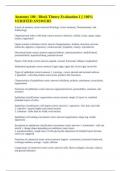Anatomy 100 - Block Theory Evaluation 1 || 100%
VERIFIED ANSWERS
4 areas of anatomy correct answers Histology, Gross Anatomy, Neuroanatomy, and
Embryology
Organizational order of the body correct answers chemical, cellular, tissue, organ, organ
system, organismal
Organ systems in humans correct answers Integumentary, skeletal, muscular, nervous,
endocrine, digestive, respiratory, cardiovascular, lymphatic, urinary, reproductive
Directional terms correct answers superior/inferior, anterior/posterior, medial/lateral,
proximal/distal, superficial/deep, parietal/visceral
Planes of the body correct answers sagittal, coronal, horizontal, oblique, longitudinal
Abdominal quadrants correct answers Upper right, upper left, lower right, lower left
Types of epithelium correct answers 1. covering - covers internal and external surfaces
2. glandular - cells that produce and excrete products like hormones
Characteristics of epithelium correct answers cellularity, polarity, attachment, avascularity,
regeneration
Functions of epithelium correct answers support/protection, permeability, sensation, and
secretion
Epithelium classification: organization correct answers simple (1 layer) vs. stratified
(multiple layers of cells)
Epithelium classification: cell shapes correct answers 1. squamous - flat, thin, and wide
2. cuboidal - square lengths and central nucleus
3. columnar - taller than its width, oval nucleus
Epithelium cell naming convention correct answers organization, shape (eg. simple
squamous)
Exceptions to epithelium classification convention correct answers 1. transitional - cells can
stretch + change shape depending on conditions, many layers
2. pseudostratified - single layer of cells giving the impression of multiple layers because
nuclei are staggered
Functions of connective tissue correct answers support + protection, structural framework,
exchange medium, storage + repair, defense
Components of connective tissue correct answers cells, fibres (collagen, reticular, elastic),
and ground substance
, Connective tissue proper types correct answers 1. loose: few fibres, lots of GS (eg. adipose)
2. dense: Many fibres, little GS (eg. elastic tissue
Supporting and specialized connective tissues correct answers 1. supporting: bone and
cartilage
2. specialized (fluid): blood and lymph
Ehlers-Danlos syndrome correct answers lack of collagen causing laxity in tissue (eg. overly
flexible joints, loose skin)
General composition of cartilage correct answers cells (chondrocytes), varied fibres, and
ground substance
Perichondrium correct answers Dense irregular connective tissue membrane covering
cartilage, providing nutrients
lacunae correct answers small spaces that house chondrocytes
types of cartilage correct answers 1. hyaline - wear-resistant, bears weight
2. fibrocartilage - tough, resistant to compression
3. elastic - in ears/epiglottis
Functions of bone correct answers support + protection, locomotion, blood cell production,
mineral metabolism
Components of bone correct answers 1. Inorganic (2/3): minerals and salts
2. Organic (1/3): cells, fibres, ground substance
Osteon repeat unit components correct answers haversian canal, bone cells, and concentric
rings
cavities of the body correct answers cranial, vertebral, mediastinum, pericardial, pleural,
abdominal, pelvic
Functions of the skeletal system correct answers support, protection, blood cell production,
storage, movement
layers of bone correct answers 1. outer cortical - hard and compact
2. inner cancellous - spongey and porous
3. medullary cavity - bone marrow, where hematopoesis occurs
types of bones correct answers long, short, flat, irregular
long bone structure (general) correct answers metaphysis, diaphysis, epiphysis
Additional features of long bones correct answers 1. articular cartilage - covers epiphysis
2. priosteum - dense connective tissue covering the bone, contains blood vessels for nutrients
3. medullary cavity - space for blood cell production
cranial bones of the skull correct answers frontal, temporal, sphenoid, parietal, occipital




